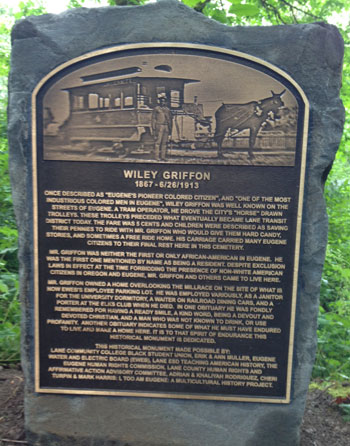 EUGENE, OR - Community members are invited to join the Lane Community College Black Student Union as they unveil a monument honoring Wiley Griffon, the first African-American mentioned by name as being a resident of Eugene.
EUGENE, OR - Community members are invited to join the Lane Community College Black Student Union as they unveil a monument honoring Wiley Griffon, the first African-American mentioned by name as being a resident of Eugene.
The event is at 5 p.m., Friday, June 7 at Hope Abbey Mausoleum in the Eugene Masonic Cemetery located at 25th Avenue and University Street.
Griffon was the first African-American mentioned by name as being a resident of Eugene, despite other unnamed African-Americans present in and around Eugene.
Griffon was the most well known operator of the draft animal-drawn trolleys, which plied the streets of Eugene and preceded the modern bus system. During the period he worked for the railroad, the University of Oregon, and the Elks Club, Griffon was likely subjected to a climate that was not welcoming to diversity. By all accounts he weathered those times positively, and was mostly respected in return.
The Griffon historical monument project grew from simply replacing Griffon's headstone, to proposed historical plaques at Lane Transit District and the Eugene Water and Electric Board offices, to a monument at the gravesite. Public and private donors contributed more than $4,000. The BSU was a major financial contributor.
"We decided as a student group that this would be something our community and our students could look back at as part of our history in Eugene," said BSU Internal Vice President Madeleine Afiafilelei Tofaeono-Galo. "We're really excited to see this in the community and to share this with the community."
This commemorative project is one of two collaborations with Lane's BSU shepherded by Cheri Turpin and Mark Harris, collaborators of "I Too, Am Eugene, A Multicultural History Project."
Harris and Turpin have dedicated the last 15 years to research and fundraising efforts to honor Griffon, who serves as a symbol for Eugene's untold multicultural past and for the unknown people buried near him.
"Wiley's not the first, but he's the first one named," Harris said. "That is an interesting sort of fame there. Why remember him, out loud, and not others?"
Even 30 years after Emancipation, local African-Americans weren't mentioned by name in historical documents such as newspaper archives.
"It doesn't serve our community to forget people who persisted during difficult times," Harris said.
Turpin said the multicultural history project is really about exploring the local community and bringing the unknown stories of local history to light. While much is known about our track and tie-dye past, less is known about our multicultural past.
"There's actually quite a rich history here," Turpin said. "When you start getting into it, it's really pretty fascinating."
"I Too, Am Eugene," seeks to bring to light the hidden history of communities of color in Eugene using print, oral, and web sources; and by supporting community historical activism such as Whilamut Talking Stones, two Tent City Re-enactments with the BSU, Teaching American History Bike and Bus Tours, and Video Projects. Additional efforts to raise awareness and to support community historical activism also include testimony in support of MLK Boulevard, Cesar Chavez Elementary, changing Sam R to Sam Reynolds Street, and sections of Lane's Rites of Passage Curricula, and other community presentations.
Turpin focuses on engaging local youth in our area's rich, but little known, multicultural history while Harris focuses on engaging local leaders and college students.
For more information:
- LCC Mark Harris: (541) 463-5178, harrism@lanecc.edu
- BSU Internal Vice President Madeleine Afiafilelei Tofaeono-Galo: (541) 499-5124
- BSU President Blair Adams: (503) 871-7525 or blair.d.adams@gmail.com
###
